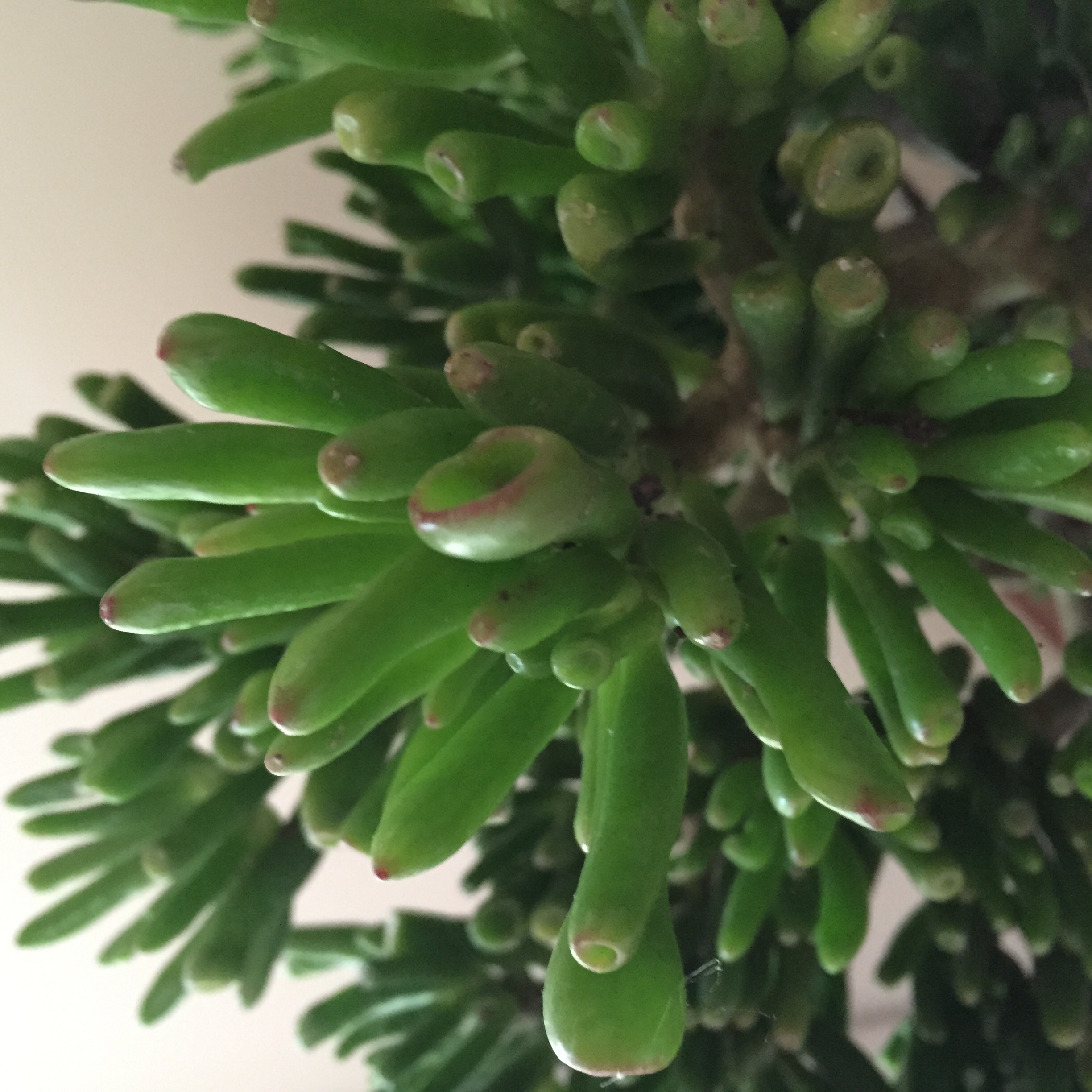Your Jade plant identification images are ready. Jade plant identification are a topic that is being searched for and liked by netizens today. You can Get the Jade plant identification files here. Download all free images.
If you’re searching for jade plant identification pictures information connected with to the jade plant identification topic, you have pay a visit to the right site. Our website always gives you suggestions for seeing the maximum quality video and picture content, please kindly hunt and find more enlightening video content and images that fit your interests.
Jade Plant Identification. Also known as dollar plant or money plant, jade plants are easily identified by their fleshy, bright green leaves and thick main stem. The plant takes its common name from the deep green of its rounded, somewhat waxy leaves. Jade plants aren’t exactly harmed by cold weather, but sudden temperature changes upset the plant, making it lose its leaves. Our expert gardening advisor, susan patterson adds, jade plants do best in soil that is coarse and sandy.
 Jade Plant Houseplants by Studley�s From houseplants.studleys.com
Jade Plant Houseplants by Studley�s From houseplants.studleys.com
A symbol of luck and prosperity, the jade plant is a meaningful emblem to activate the energy in any space. It can grow to up to 4ft and can be pruned and maintained as a shrub. Keep their leaves free of dust for optimal photosynthesis, oxygen production, and natural shine. Identification of the jade plant is by its thick trunk and multitude of leafy stems. But they are largely known as jade plant, because the dark green color of the leaves is resembling jade. Also known as dollar plant or money plant, jade plants are easily identified by their fleshy, bright green leaves and thick main stem.
Jade plant (crassula ovata) the jade plant is a small shrub and popular houseplant.
The soil will usually be waterlogged and the roots will show signs of root rot. Jade plants do an excellent job of removing common indoor toxins from our air, especially toluene and acetone. Like all succulents, its supple leaves store water for long periods of time. Its popularity as an ornamental. The branches are thick, the leaves fleshy and rounded, and they grow in opposite pairs. Compared to other jade plants, this dwarf jade has smaller leaves that grow an inch (2.5 cm) long.
 Source: pinterest.com
Source: pinterest.com
Commonly called the money plant, lucky plant, and friendship tree, jades are evergreen plants and produces small white or pink flowers. If your jade plant is exposed to very high or very low temperatures, it will start losing its leaves. The crassula arbosescens blue bird variegata is commonly known as the blue bird money plant or jade plant. This succulent is also called lucky plant, money plant or money tree. Jade plants are happiest in.
 Source: pinterest.com
Source: pinterest.com
For e.g., the jade plant sends aerial roots, which is a rare sight in succulents. Identification of the jade plant is by its thick trunk and multitude of leafy stems. For e.g., the jade plant sends aerial roots, which is a rare sight in succulents. Jade plants, rare jade plants, exotic jade plants, crassula ovata, crassula arborescens, jade plant care, gollum, www.thejadeplant.com money tree. Types of jade plant identification crassula varieties | names and care guide with moody.
 Source: pinterest.com
Source: pinterest.com
It is a 2 to 4 ft succulent shrub. Jade plants are named binomially as crassula ovata from the genus crassula. It has round gray “silver dollar” leaves. Jade plant, more correctly known as crassula ovata, is a popular succulent, rich in symbolism, and is commonly grown as a houseplant. Jade plant (crassula ovata) the jade plant is a small shrub and popular houseplant.
 Source: pinterest.com
Source: pinterest.com
Also known as dollar plant or money plant, jade plants are easily identified by their fleshy, bright green leaves and thick main stem. Keep their leaves free of dust for optimal photosynthesis, oxygen production, and natural shine. It has a thick, succulent trunk and branches, and can resemble a small tree. Be very careful not to overwater. It is a 2 to 4 ft succulent shrub.
 Source: pinterest.com
Source: pinterest.com
Jade plants are happiest in. Your jade is not diseased. It has round gray “silver dollar” leaves. Jade plants are happiest in. The symptoms of overwatering a jade plant are yellowing leaves, leaf drop, soft leaves and dry leaves.
 Source: pinterest.com
Source: pinterest.com
Jade plant care guide light. The thick, succulent leaves are opposite, obovate and often have red edges. Commonly called the money plant, lucky plant, and friendship tree, jades are evergreen plants and produces small white or pink flowers. Its popularity as an ornamental. Plant identification learning module:flowers and foliage.
 Source: pinterest.fr
Source: pinterest.fr
Crassula arborescens, the silver dollar jade plant, is an endemic plant of the western cape, south africa. Your jade is not diseased. But they are largely known as jade plant, because the dark green color of the leaves is resembling jade. But if you are still confused about it, you can look for some of the other features. Like all succulents, its supple leaves store water for long periods of time.
 Source: pinterest.com
Source: pinterest.com
Also known as dollar plant or money plant, jade plants are easily identified by their fleshy, bright green leaves and thick main stem. How to get bugs, pests, and diseases off jade plants. With just a bit of care, it can grow to be between 3 and 6 feet tall, but it does so slowly, growing about 2 inches a year. Jade plant care guide light. The above three characteristics are good enough to identify the succulent plant.
 Source: pinterest.com.mx
Source: pinterest.com.mx
My first observation is that your jade is not getting as much sunlight as you think because it is off to the side of the window and against a wall. It has a thick, succulent trunk and branches, and can resemble a small tree. The main identification of this jade plant is its elongated oval leaves with lime green and yellow stripes. If your jade plant is exposed to very high or very low temperatures, it will start losing its leaves. Great growth will come from being placed in a position with a great deal of natural sunlight.
 Source: houseplant411.com
Source: houseplant411.com
With just a bit of care, it can grow to be between 3 and 6 feet tall, but it does so slowly, growing about 2 inches a year. This succulent is also called lucky plant, money plant or money tree. It can grow to up to 4ft and can be pruned and maintained as a shrub. Jade ( crassula spp.) is a succulent plant native to the desert region of south africa with different types of jade plants to add a little variety to your indoor plant collection. Jade plants are named binomially as crassula ovata from the genus crassula.
 Source: pinterest.com
Source: pinterest.com
It is a 2 to 4 ft succulent shrub. Jade plant (crassula ovata) the jade plant is a small shrub and popular houseplant. These diseases are easy to identify and can be treated or dealt with when they are discovered. Identification of the jade plant is by its thick trunk and multitude of leafy stems. My first observation is that your jade is not getting as much sunlight as you think because it is off to the side of the window and against a wall.
 Source: pinterest.com
Source: pinterest.com
How to identify the real crassula ovata jade plant ? This succulent is also called lucky plant, money plant or money tree. Compared to other jade plants, this dwarf jade has smaller leaves that grow an inch (2.5 cm) long. The above three characteristics are good enough to identify the succulent plant. How to get bugs, pests, and diseases off jade plants.
 Source: pinterest.com
Source: pinterest.com
Ovata has been grown as an indoor ornamental in europe, north america, east asia and practically worldwide for over a hundred years.it is also popular as a landscape plant in mild climates. Also called the money tree plant or money plant, the jade plant is an evergreen perennial succulent. How to identify the real crassula ovata jade plant ? If your jade plant is exposed to very high or very low temperatures, it will start losing its leaves. Crassula arborescens, the silver dollar jade plant, is an endemic plant of the western cape, south africa.
 Source: pinterest.com
Source: pinterest.com
Types of jade plant identification crassula varieties | names and care guide with moody. It can be identified by its reddish stems and long, skinny, light green leaves. While it is relatively low maintenance and can thrive in a wide variety. These leaves grow up to 5cm long, forming red edges when it receives a lot of light. If your jade plant is exposed to very high or very low temperatures, it will start losing its leaves.
 Source: pinterest.com
Source: pinterest.com
It has a thick, succulent trunk and branches, and can resemble a small tree. The above three characteristics are good enough to identify the succulent plant. A symbol of luck and prosperity, the jade plant is a meaningful emblem to activate the energy in any space. It has a thick, succulent trunk and branches, and can resemble a small tree. The diseases that affect the jade plant include bacterial soft rot, powdery mildew and black ring disease.
 Source: pinterest.com
Source: pinterest.com
Jade plant (crassula ovata) the jade plant is a small shrub and popular houseplant. Identification of the jade plant is by its thick trunk and multitude of leafy stems. Ovata has been grown as an indoor ornamental in europe, north america, east asia and practically worldwide for over a hundred years.it is also popular as a landscape plant in mild climates. Also known as dollar plant or money plant, jade plants are easily identified by their fleshy, bright green leaves and thick main stem. Jade plants aren’t exactly harmed by cold weather, but sudden temperature changes upset the plant, making it lose its leaves.
 Source: pinterest.com
Source: pinterest.com
Jade plant (crassula ovata) the jade plant is a small shrub and popular houseplant. This species looks much like the traditional jade plant (crassula ovata). It has a thick, succulent trunk and branches, and can resemble a small tree. Also known as dollar plant or money plant, jade plants are easily identified by their fleshy, bright green leaves and thick main stem. Like all succulents, its supple leaves store water for long periods of time.
 Source: thriftyfun.com
Source: thriftyfun.com
Follow the tips and advice below to identify an overwatered jade plant and learn how you can treat and revive it. It is a 2 to 4 ft succulent shrub. It can grow to up to 4ft and can be pruned and maintained as a shrub. How to get bugs, pests, and diseases off jade plants. The elongated stem spaces between the older and newer leaf sets are.
This site is an open community for users to submit their favorite wallpapers on the internet, all images or pictures in this website are for personal wallpaper use only, it is stricly prohibited to use this wallpaper for commercial purposes, if you are the author and find this image is shared without your permission, please kindly raise a DMCA report to Us.
If you find this site good, please support us by sharing this posts to your favorite social media accounts like Facebook, Instagram and so on or you can also bookmark this blog page with the title jade plant identification by using Ctrl + D for devices a laptop with a Windows operating system or Command + D for laptops with an Apple operating system. If you use a smartphone, you can also use the drawer menu of the browser you are using. Whether it’s a Windows, Mac, iOS or Android operating system, you will still be able to bookmark this website.







